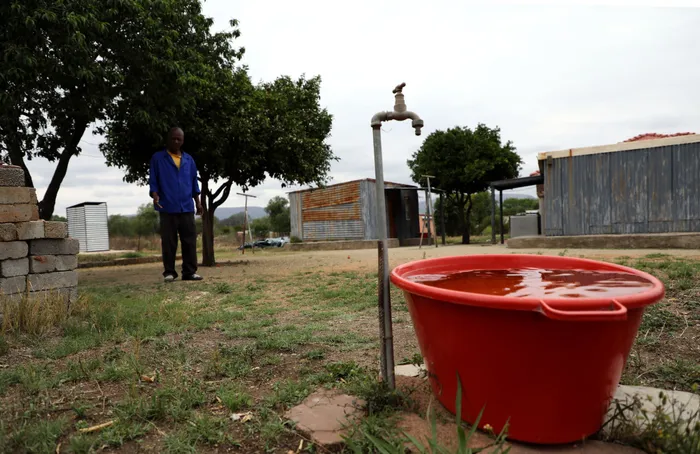Reversing apartheid’s spatial reality

Picture: Oupa Mokoena/African News Agency (ANA) – The embattled Madibeng local manicipality is plagued by poor service delivery such as poor road infrastucture, erratic water supply, housing problems, unreliable power supply and pit toilets. We should ensure that in district and metropolitan areas, we use the range of human resources to co-ordinate and synchronise infrastructure plans and budgets from all spheres of government, the writers say.
By Michael Sutcliffe and Sue Bannister
The National Development Plan targets infrastructure investment of 30 percent as a percentage of GDP by 2030. However, National Treasury estimated that between 2010 and 2020, public‐sector capital investment averaged 5.8 percent of GDP, while private capital investment averaged 11.2 percent of GDP.
Overall, in 2020, capital investment was around 13.7 percent of GDP, in large part due to weak growth, rising spending pressures, and of course, state capture and the consequential impact this had on delivery as a whole. Clearly, the NDP target is not being met, and to reach this target, the public sector investment would need to grow from 3.9 percent of GDP in 2020 to 10 percent of GDP by 2030, while private‐sector investment in infrastructure would need to grow from 9.8 percent of GDP in 2020 to 20 percent in 2030.
While there are national initiatives to try and reverse this trend, the jury is still out on whether these initiatives will have the desired impact. Public sector infrastructure spending over the 2022 medium-term expenditure framework (MTEF) period is estimated at R812.5 billion, and this is accomplished through over 750 public-sector institutions operating in the national, provincial and local spheres of government.
State‐owned companies continue to be the largest contributor to capital investment, spending a projected R251.7bn over the next three years, and municipalities are the next largest public sector player, forecasted to spend R194.4bn, around a quarter of the total.
The important role of municipalities cannot be underestimated, given their focus on delivering basic network services. Infrastructure delivery is primarily about good asset management, with strategies to provide for new investment, renewal of existing assets and upgrading of existing assets. This year, for example, over R67bn will be spent in terms of capital budgets across all municipalities, with over R42bn (63 percent) on new, R11.1bn (16 percent) on renewal and R13.8bn (21 percent) on upgrading.
The key focus areas are water and sanitation (37 percent), roads and stormwater (22 percent) and electricity (10 percent). Importantly, the first and possibly most important challenge we have to address is around getting the balance between providing for new assets versus the renewal and upgrading of existing assets.
This is not easy and is complicated, given our history where black South Africans were not only completely under-provided for in terms of basic network infrastructure, but they were forcibly removed and located in areas which were far from the heartland of the economy. As a result, in the post-1994 period, we find many black households having to cover costs relating to three different residences: one where apartheid forced them to live, one where they had received a house post-apartheid, usually in a township area, and one close to work opportunities in a backyard rental or shack area.
In such circumstances, planning for this and implementing infrastructure programmes is not easy and has resulted in the required balance between renewal/upgrading on the one hand and provision of new infrastructure on the other, not being met.
This is evidenced if one examines the index used to measure repairs and maintenance as a percentage of property, plant and equipment. Municipalities should be striving for a proportion of around 13 percent, but this is not being achieved.
This is particularly true of the 8 Category A (Metropolitan) municipalities which hold some 50 percent of the total infrastructure asset inventory of municipalities (measured in terms of property, plant and equipment – written down value.
These eight municipalities range in size from Nelson Mandela Bay, having around R19bn assets, to Johannesburg, with R84bn assets. Of these eight, only Cape Town has a repairs and maintenance percentage of 10 percent, with eThekwini at 5 percent and the rest, including the economic hubs in Gauteng, with less than 5 percent.
This is simply not sustainable, and these municipalities, and many others, must reverse this trend and ensure they are spending far more on repairs and maintenance. At the same time, though, the apartheid spatial reality must change, and this means that particularly the urban land situation must be addressed. Here, mechanisms to free up space in urban areas must be prioritised in order to provide housing opportunities for lower-income individuals or families.
There are mechanisms which can be used to do this, including, for example, charging owners significantly higher property rates for undeveloped (and well-located) land. Municipalities could also expropriate such land, including vacant buildings for the redevelopment of social housing or commercial/industrial enterprises.
Importantly, too, municipalities should develop asset management plans based on the social, economic and environmental needs of the municipality as a whole. For example, should we be prioritising all roads equally without considering how many residents or commuters are being served? Finally, we need to deal with the competency levels of officials in the built environment sectors across all spheres of government.
This cannot be solved by piecemeal efforts and is one area in which the District Development Model processes could be activated. We should ensure that in district and metropolitan areas, we use the range of human resources to co-ordinate and synchronise infrastructure plans and budgets from all spheres of government. This will ensure that, where necessary, the collective delivery and built environment skills across these municipalities are properly used to benefit the communities they are serving, rather than having the over 750 infrastructure delivery agencies of the state working as separate islands.
Sutcliffe and Bannister are Directors at City Insight (Pty) Ltd